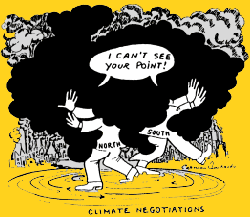
|
 |
 |
| |
|
Please do That’s what scientists are saying  Business is running ahead
of science at CoP-8. Even as cohorts of corporations, non-governmental
organisations (NGOs) and nation-states stalk Vigyan Bhavan corridors vending their clean
development mechanism (CDM) deals, scientists at the Intergovernmental Panel on Climate
Change’s (IPCC’s) special review meeting on October 28, 2002 cautioned that the
world will have to do far more than just grow trees or introduce carbon-efficient cars if
we are to abort the dangerous impacts of imminent climate change. Indeed, new global
climate models developed at the Hadley Centre for Climate Prediction and Research predict
that stabilising carbon dioxide concentrations at say 450-550 parts per million (ppm) may
not be good enough in the long run. The models, which take into account complex coupling
between climate and carbon cycles, predict that the as yet poorly-understood carbon cycle
may eventually allow a greater fraction of carbon emissions to stay in the atmosphere,
upsetting calculations on which most CDM deals are now premised. Business is running ahead
of science at CoP-8. Even as cohorts of corporations, non-governmental
organisations (NGOs) and nation-states stalk Vigyan Bhavan corridors vending their clean
development mechanism (CDM) deals, scientists at the Intergovernmental Panel on Climate
Change’s (IPCC’s) special review meeting on October 28, 2002 cautioned that the
world will have to do far more than just grow trees or introduce carbon-efficient cars if
we are to abort the dangerous impacts of imminent climate change. Indeed, new global
climate models developed at the Hadley Centre for Climate Prediction and Research predict
that stabilising carbon dioxide concentrations at say 450-550 parts per million (ppm) may
not be good enough in the long run. The models, which take into account complex coupling
between climate and carbon cycles, predict that the as yet poorly-understood carbon cycle
may eventually allow a greater fraction of carbon emissions to stay in the atmosphere,
upsetting calculations on which most CDM deals are now premised.
The world should not only have to cut down carbon emissions drastically to avoid dangerous climate change — an overarching notion that the IPCC put out in a session devoted to the possible contours of the next (fourth) assessment report — but have to do it with a great sense of urgency. David Carson, director, World Climate Research Centre, argues that using forests as sinks may work only in the short-term. Models predict that, by 2050, most forests should have exhausted their capacity to absorb carbon, and eventually become sources of carbon. Furthermore, explains W Steffen, executive director, International Geosphere-Biosphere Programme, given the complex nature of the carbon cycle, it would be difficult to assess the precise impact of CDM projects on carbon concentrations in the long run. The billion dollar question is: should policymakers wait for scientists to tell them upto a reasonable degree which of the many scenarios thrown up by climate models is most likely, or should they go ahead, taking a worst-case scenario as the most likely one. Scientists say they can’t discriminate between science and value judgement, and it is up to each country to decide what seems reasonable to them. The fourth assessment report, to be completed by 2007, would try to narrow the range of choices available to the policymaker. But Carson feels it will be really difficult to achieve this in the two years they have been given — all studies must have concluded by 2004, the next three years being reserved for peer review. The next assessment will also focus on regional impacts of climate change which, along with climate change predictions, will give policymakers a rough yardstick to plan the development of their respective countries. Steffen says a better understanding of regional climate change could provide a basis for climate justice. "For instance, there is growing evidence that the Sahelian drought of the 1970s was caused by aerosols emitted in the North American region. If established, the affected victims could sue the culprits for endangering their survival," he says. It could be a while before scientists put together the jumbled pieces of the climate jigsaw. But people like Steffen and Carson would like policymakers to err on the side of caution, simply because it’s already too late. "Had we heeded the early warnings in the 1970s, we would have been in a better position to tackle climate change," Carson says. Most scientists opine it is imperative the world begins to cut down on carbon emissions in earnest, in significant amounts and with alacrity, to avoid dangerous climate change. In the meantime, nations must strive to understand their respective climate systems better to adopt development strategies that mitigate climate change impacts on people.
|
|
|||
|
Copyright © CSE Centre for Science and Environment